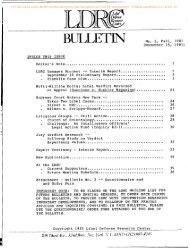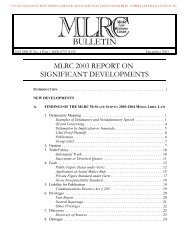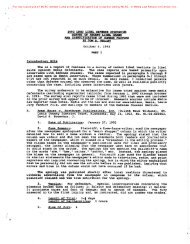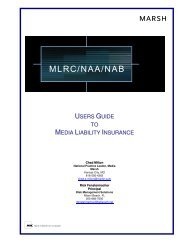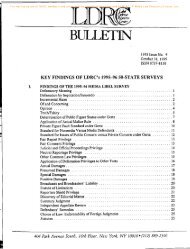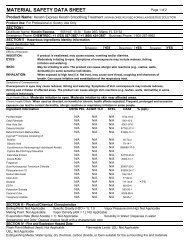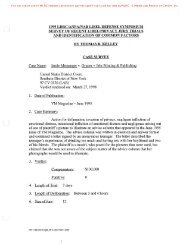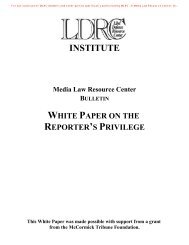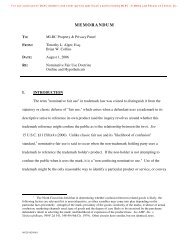What is libel by implication? - Directrouter.com
What is libel by implication? - Directrouter.com
What is libel by implication? - Directrouter.com
Create successful ePaper yourself
Turn your PDF publications into a flip-book with our unique Google optimized e-Paper software.
For exclusive use of MLRC members and other parties specifically authorized <strong>by</strong> MLRC. © Media Law Resource Center, Inc.<br />
Practice questions/topics:<br />
OUTLINE FOR SEPTEMBER 2006 SEMINAR<br />
LIBEL BY IMPLICATION – CURRENT TRENDS<br />
• <strong>What</strong> <strong>is</strong> <strong>libel</strong> <strong>by</strong> <strong>implication</strong>?<br />
• <strong>What</strong> fact scenarios have given r<strong>is</strong>e to viable claims?<br />
• How do you recognize potential r<strong>is</strong>k(s) when vetting material?<br />
• Are there ways to minimize those r<strong>is</strong>k(s)?<br />
• How do you defend <strong>libel</strong> <strong>by</strong> <strong>implication</strong> claims?<br />
A. Definition(s)<br />
Libel or defamation <strong>by</strong> <strong>implication</strong> “has be<strong>com</strong>e a catchword for any<br />
claim of defamatory meaning that goes beyond what the words<br />
themselves denote.” 1 Courts have defined the tort in various ways,<br />
including:<br />
1. Libel <strong>by</strong> <strong>implication</strong> occurs when a defendant (1) juxtaposes a<br />
series of facts to as to imply a defamatory connection between<br />
them, or (2) creates a defamatory <strong>implication</strong> even though the<br />
particular facts are correct. Toney v. WCCO, 85 F.3d 383 (8th<br />
Cir. 1996).<br />
2. A publication can convey a false and defamatory meaning <strong>by</strong><br />
omitting or juxtaposing facts, even though all of the individual<br />
statements considered in <strong>is</strong>olation are literally true or nondefamatory.<br />
Turner v. KTRK Telev<strong>is</strong>ion, Inc., 38 S.W.3d 103<br />
(Tex. 2000).<br />
3. Implied defamation occurs when a publication states facts that<br />
are literally true, but produces a defamatory meaning apparent<br />
from a plain reading of the publication in its entirety. Chapin v.<br />
Knight-Ridder, Inc., 993 F.2d 1087 (4th Cir. 1993).<br />
1<br />
Thomas B. Kelley & Steven D. Zansberg, Libel <strong>by</strong> Implication,<br />
Commun. Law. (Spring 2002).
For exclusive use of MLRC members and other parties specifically authorized <strong>by</strong> MLRC. © Media Law Resource Center, Inc.<br />
B. Fact patterns resulting in viable claims<br />
Libel <strong>by</strong> <strong>implication</strong> recently has been found in a various fact<br />
scenarios, which can be generally categorized as follows:<br />
1. False <strong>implication</strong>s ar<strong>is</strong>ing from true facts:<br />
a. Stevens v. Iowa Newspapers, Inc., 711 N.W. 2d 732<br />
(Table), 2006 WL 126626, 34 Med. L. Rep. 1430 (Iowa<br />
Ct. App. 2006): Plaintiff, a freelance sports writer, sued<br />
the Ames Tribune and a sports writer alleging defamation<br />
ar<strong>is</strong>ing from a column which criticized plaintiff’s<br />
journal<strong>is</strong>tic practices in response to an earlier column<br />
plaintiff had written. The trial court entered summary<br />
judgment in favor of defendants. On appeal, after<br />
concluding that the column’s statement that plaintiff<br />
“rarely attended events upon which he wrote columns”<br />
was “literally true” and “not directly defamatory,” the<br />
court held the statement was actionable. Specifically, the<br />
court found that a “reasonable juror” could find that the<br />
sports writer intended to convey the defamatory message<br />
that plaintiff was professionally in<strong>com</strong>petent. The court<br />
based its ruling in part on the sports writer’s<br />
testimony that, although the statement was not intended<br />
as a <strong>com</strong>ment on plaintiff’s professional credibility, it<br />
was intended to express that plaintiff often offered<br />
opinions which had no bas<strong>is</strong> in fact or research.<br />
b. Johnson v. Columbia Broad. Sys., Inc., 10 F. Supp. 2d<br />
1071 (D. Minn. 1998): Plaintiff, a cosmetic surgeon,<br />
sued a telev<strong>is</strong>ion station ar<strong>is</strong>ing from a broadcast about<br />
h<strong>is</strong> practice entitled “Scarred for Life.” Because the<br />
alleged defamation arose from statements implied from,<br />
rather than directly contained in, the broadcast, the court<br />
required plaintiff to establ<strong>is</strong>h that the broadcast was<br />
capable of being interpreted as alleged and that defendant<br />
intended the alleged <strong>implication</strong>s. To resolve these<br />
questions, the court used a five-step analys<strong>is</strong>: (1) <strong>is</strong> the<br />
alleged statement capable of being proved true or false;<br />
(2) <strong>is</strong> the relevant portion of the broadcast susceptible to<br />
2
For exclusive use of MLRC members and other parties specifically authorized <strong>by</strong> MLRC. © Media Law Resource Center, Inc.<br />
the <strong>implication</strong> alleged; (3) did defendant intend the<br />
alleged <strong>implication</strong>; (4) <strong>is</strong> the alleged <strong>implication</strong> in fact<br />
false; and (5) would a person in the exerc<strong>is</strong>e of<br />
reasonable care have known the <strong>implication</strong> was false?<br />
Applying th<strong>is</strong> analys<strong>is</strong>, the court found the found the<br />
broadcast contained several actionable <strong>implication</strong>s<br />
which should be determined <strong>by</strong> a jury. In th<strong>is</strong> regard, the<br />
court found that there were “fact <strong>is</strong>sues” as to defendant’s<br />
intent ra<strong>is</strong>ed <strong>by</strong> the “context” and “tenor” of the<br />
broadcast.<br />
2. Juxtaposition and om<strong>is</strong>sion:<br />
a. West v. Media General Operations, Inc., 120 F. App’x.<br />
601, 33 Med. L. Rep. 1321 (6th Cir. 2005): Plaintiffs, a<br />
probation counseling center and its owner, sued a<br />
telev<strong>is</strong>ion station for defamation ar<strong>is</strong>ing from a 4-part<br />
investigative series detailing the “cozy relationship”<br />
between the center and local judges entitled “Probation<br />
for Sale.” After a jury awarded damages, the telev<strong>is</strong>ion<br />
station appealed. Although the Sixth Circuit reversed the<br />
award on other grounds, it held that plaintiffs were<br />
entitled to sue on various implied “topics” ar<strong>is</strong>ing from<br />
defendant’s alleged juxtaposition of v<strong>is</strong>ual and audio<br />
<strong>com</strong>ponents. Plaintiffs were not required to identify<br />
specific statements contained in the broadcast which they<br />
alleged were defamatory. In so ruling, the Court stated<br />
that the “video context” in which a statement <strong>is</strong> made<br />
must be examined because “a telev<strong>is</strong>ion director or<br />
reporter can, in many subtle ways, alter the tone and<br />
meaning of an otherw<strong>is</strong>e innocuous broadcast through<br />
video and audio editing techniques.” Accordingly, a<br />
telev<strong>is</strong>ion news report can “imply a defamatory<br />
statement” not specifically stated through a <strong>com</strong>bination<br />
of statements and v<strong>is</strong>ual effects.<br />
b. Franklin Prescriptions, Inc. v. The New York Times Co.,<br />
267 F. Supp. 2d 425 (E. D. Pa. 2003): Plaintiff pharmacy<br />
sued for defamation ar<strong>is</strong>ing from an article concerning<br />
unscrupulous online pharmacies, which take e-mail<br />
3
For exclusive use of MLRC members and other parties specifically authorized <strong>by</strong> MLRC. © Media Law Resource Center, Inc.<br />
orders for controlled and other drugs without requiring a<br />
prescription. Although there was no specific reference to<br />
plaintiff within the article, it did contain an edited version<br />
of plaintiff’s “web-grab” (a printout of plaintiff’s website<br />
used as photograph). The court denied defendant’s<br />
motion for summary judgment, ruling that the<br />
juxtaposition of plaintiff’s web-grab without explanatory<br />
information included in plaintiff’s website regarding the<br />
necessity of having a prescription “could lead a<br />
reasonable person to believe that [plaintiff] engages in<br />
the exact type of conduct described” in the article.<br />
Because the plaintiff was a private figure, the court<br />
refused to require plaintiff to prove that defendant<br />
endorsed the defamatory <strong>implication</strong>.<br />
c. Turner v. KTRK Telev<strong>is</strong>ion, Inc., 38 S.W.3d 103 (Tex.<br />
2000): Plaintiff mayoral candidate sued telev<strong>is</strong>ion station<br />
for <strong>libel</strong> ar<strong>is</strong>ing from news broadcast questioning h<strong>is</strong> role<br />
in a life insurance scam. Although the Texas Supreme<br />
Court affirmed the reversal of a jury verdict in plaintiff’s<br />
favor, it held that plaintiff could state a cause of action<br />
for implied defamation based on the “publication as a<br />
whole” rather than on specific false statements. In so<br />
ruling, the court identified several key facts omitted from<br />
the broadcast which would have more accurately<br />
portrayed plaintiff’s role in the transaction at <strong>is</strong>sue. By<br />
omitting these facts, and falsely juxtaposing others, the<br />
“broadcast’s m<strong>is</strong>leading account cast more suspicion on<br />
[plaintiff’s] conduct than a substantially true account<br />
would have done.”<br />
3. False <strong>implication</strong>s from false facts and/or opinions<br />
a. Hatfill v. The New York Times Co., 416 F.3d 320 (4th<br />
Cir. 2005): Plaintiff sued for defamation and other<br />
claims ar<strong>is</strong>ing from a series of columns which ra<strong>is</strong>ed<br />
questions and expressed opinions about the FBI’s<br />
investigation of the anthrax mailings. Plaintiff asserted<br />
that the columns falsely implied that he was involved in<br />
the mailings. The circuit court reversed the d<strong>is</strong>trict court<br />
4
For exclusive use of MLRC members and other parties specifically authorized <strong>by</strong> MLRC. © Media Law Resource Center, Inc.<br />
d<strong>is</strong>m<strong>is</strong>sal of the action, ruling that a defamatory charge<br />
may be made expressly or <strong>by</strong> “inference, <strong>implication</strong> or<br />
insinuation.” The court held that the columns, taken<br />
together, focused only on plaintiff, which likely would<br />
lead a reasonable reader to conclude that plaintiff was<br />
responsible for the mailings. Moreover, th<strong>is</strong><br />
“unm<strong>is</strong>takable theme” was not sufficiently clarified <strong>by</strong><br />
the column<strong>is</strong>t’s caution to readers that plaintiff should be<br />
presumed innocent, or h<strong>is</strong> statement that the FBI should<br />
either arrest or clear plaintiff.<br />
b. Schlieman v. Gannett Minnesota Broad., Inc., 637<br />
N.W.2d 297 (Minn. Ct. App. 2001): Plaintiff police<br />
officer sued telev<strong>is</strong>ion station alleging defamation <strong>by</strong><br />
<strong>implication</strong> ar<strong>is</strong>ing from an investigative news report<br />
about the shooting of a citizen. In considering the lower<br />
court’s jury instruction barring consideration of whether<br />
juxtaposition or om<strong>is</strong>sion was a bas<strong>is</strong> to find defamation<br />
<strong>by</strong> <strong>implication</strong> because of plaintiff’s status as a public<br />
figure, the court held that the instruction was defective.<br />
In so ruling, the court d<strong>is</strong>tingu<strong>is</strong>hed earlier rulings which<br />
establ<strong>is</strong>hed that a public-official plaintiff could not base a<br />
defamation <strong>by</strong> <strong>implication</strong> claim on true statements.<br />
Specifically, the court held that defamatory meaning<br />
should be d<strong>is</strong>tinct from falsity for purposes of proving a<br />
defamation <strong>by</strong> <strong>implication</strong> claim based on false facts, and<br />
plaintiff accordingly could rely on juxtaposition and<br />
omitted facts to find defamatory meaning.<br />
c. Gjonlekaj v. SOT, 308 A.D.2d 471 (N. Y. App. Div.<br />
2003): Plaintiff, a publ<strong>is</strong>her of a rival Albanian<br />
newspaper, sued h<strong>is</strong> <strong>com</strong>petitor for <strong>libel</strong> ar<strong>is</strong>ing from a<br />
news article which concerned plaintiff’s alleged claim of<br />
sole credit for the idea of publ<strong>is</strong>hing an Albanian<br />
translation of a book written <strong>by</strong> Pope John Paul II. The<br />
article at <strong>is</strong>sue characterized plaintiff as a “left<strong>is</strong>t<br />
bookseller” who dealt in Commun<strong>is</strong>t propaganda in<br />
Albania. The article further stated that many “newly<br />
arrived Albanians don’t know [plaintiff’s] background,<br />
but to many of us who know him very well he <strong>is</strong> a<br />
5
For exclusive use of MLRC members and other parties specifically authorized <strong>by</strong> MLRC. © Media Law Resource Center, Inc.<br />
representative of Marx<strong>is</strong>t ideology” which was<br />
destructive to Albania. The court denied defendant’s<br />
motion to d<strong>is</strong>m<strong>is</strong>s, holding that these statements implied<br />
that defendant had knowledge of certain facts not known<br />
to readers which supported h<strong>is</strong> defamatory opinion<br />
regarding plaintiff.<br />
C. Libel <strong>by</strong> <strong>implication</strong> d<strong>is</strong>gu<strong>is</strong>ed as false light<br />
1. False light <strong>is</strong> a form of invasion of privacy which <strong>is</strong> actionable<br />
where a publication places an individual <strong>is</strong> a “false light” before<br />
the public if (a) the false light <strong>is</strong> highly unreasonable; and (2)<br />
the publ<strong>is</strong>her had knowledge of or acted in reckless d<strong>is</strong>regard<br />
as to the falsity of the publicized matter and the false light in<br />
which the individual would be placed. Restatement (Second) of<br />
Torts §652(E) (1977).<br />
2. Th<strong>is</strong> language unfortunately has led some courts to declare that<br />
false light does not require a false statement of fact, only a<br />
statement placing a person in a false light. See, e.g., Heekin v.<br />
CBS Broad., Inc., 789 So. 2d 355 (Fla. 2d DCA 2001);<br />
Goodbehere v. Phoenix Newspapers, 783 P.2d 781 (Ariz.<br />
1989). Th<strong>is</strong> concept has opened the door for claims based on<br />
implied meaning, which typically would not survive scrutiny<br />
under traditional defamation standards, or where <strong>com</strong>panion<br />
defamation claims fail. For example:<br />
a. Anderson v. Gannett Co., Inc., et al., Case No. 2001-CA-<br />
1728, First Judicial Circuit Court, Escambia County,<br />
Florida: In Anderson, the plaintiff <strong>is</strong> the owner and<br />
founder of a large road paving <strong>com</strong>pany -- Anderson<br />
Columbia -- based on Lake City, Florida. During a fiveday<br />
period in December 1998, the defendant Pensacola<br />
News Journal publ<strong>is</strong>hed a series of articles concerning<br />
problems between Anderson Columbia and state<br />
regulators. One of the stories in the series reported on<br />
Anderson Columbia’s political contributions and<br />
d<strong>is</strong>cussed a pending federal grand jury investigation of<br />
the <strong>com</strong>pany’s political connections. The article also<br />
reported that Joe Anderson had been indicted <strong>by</strong> an<br />
6
For exclusive use of MLRC members and other parties specifically authorized <strong>by</strong> MLRC. © Media Law Resource Center, Inc.<br />
D. Defenses<br />
earlier federal grand jury and charged with bribing local<br />
government officials to obtain road work. Anderson<br />
pleaded guilty to mail fraud and was sentenced to<br />
probation. The article also accurately reported that<br />
Anderson’s probation was extended because he had<br />
“shot and killed h<strong>is</strong> wife” with a shotgun he was barred<br />
from possessing. The article’s next sentence explains<br />
where the death occurred and that Joe Anderson had filed<br />
for divorce, followed <strong>by</strong> a sentence that stated: “Law<br />
enforcement officials determined the shooting was a<br />
hunting accident.” Based primarily on these three<br />
sentences, plaintiff sued for false light alleging although<br />
the article was literally true, it placed him in a false light<br />
as having murdered h<strong>is</strong> wife. Following a lengthy trial, a<br />
jury found in Anderson’s favor and awarded him more<br />
than $18 million. An appeal of the verdict currently <strong>is</strong><br />
pending in Florida’s First D<strong>is</strong>trict Court of Appeal.<br />
Even where <strong>libel</strong> <strong>by</strong> <strong>implication</strong> and related torts have been<br />
recognized as a viable claims, courts have employed traditional,<br />
constitutionally-based and tort-specific defenses in rejecting such<br />
claims. For example,<br />
1. Truth<br />
a. Nichols v. Moore, 396 F. Supp. 2d 783 (E.D. Mich.<br />
2005): Plaintiff, the brother of Oklahoma City Bomber<br />
Terry Nichols, sued for defamation <strong>by</strong> <strong>implication</strong> and<br />
false light ar<strong>is</strong>ing from defendant’s documentary film<br />
regarding guns and violence in Anerica. The court<br />
granted summary judgment on plaintiff’s defamation<br />
claims, finding that he failed to demonstrate the<br />
publication contained false statements, <strong>implication</strong>s or<br />
omitted material factual statements. Plaintiff’s false light<br />
and emotional d<strong>is</strong>tress claims failed for the same reasons.<br />
b. Mohr v. Grant, 108 P.3d 768 (Wash. 2005): Plaintiffs,<br />
the owners of an interior design firm, sued a telev<strong>is</strong>ion<br />
7
For exclusive use of MLRC members and other parties specifically authorized <strong>by</strong> MLRC. © Media Law Resource Center, Inc.<br />
station for defamation ar<strong>is</strong>ing from broadcasts<br />
concerning the arrest and prosecution of an mentallyhandicapped<br />
individual ar<strong>is</strong>ing from an incident at<br />
plaintiffs’ store. Plaintiffs alleged inter alia that<br />
defendant omitted material facts which resulted in<br />
defamation <strong>by</strong> <strong>implication</strong>. The court ruled that the<br />
telev<strong>is</strong>ion station was entitled to summary judgment<br />
because plaintiff failed to establ<strong>is</strong>h falsity, i.e., that the<br />
alleged false impression conveyed <strong>by</strong> the broadcasts<br />
would be contradicted <strong>by</strong> the inclusion of omitted facts.<br />
Specifically, the court found that the omitted information<br />
would not have negated the alleged defamatory<br />
<strong>implication</strong> in its entirety, and the broadcasts therefore<br />
were not actionable.<br />
c. Proskin v. Hearst Corp., 14 A.D.3d 782 (N.Y. App. Div.<br />
2005): Plaintiff, a former d<strong>is</strong>trict attorney and judge,<br />
sued newspaper for defamation ar<strong>is</strong>ing from article<br />
reporting h<strong>is</strong> criminal conviction had been overturned<br />
based on ineffective ass<strong>is</strong>tance of counsel. The article<br />
reported that h<strong>is</strong> career had stalled after public<br />
revelations that he had altered a client’s will to leave her<br />
money to h<strong>is</strong> own children. The court rejected plaintiff’s<br />
allegation that the article implied h<strong>is</strong> actions were<br />
criminal and defamed him because it failed to state that<br />
he altered the will at the client’s request. Rather, the<br />
court held that because the article did not affirmatively<br />
state plaintiff had done anything illegal or criminal,<br />
plaintiff’s defamation claim must fail.<br />
d. Montefusco v. ESPN, Inc., 47 F. App’x. 124, 2002 WL<br />
31108927, 30 Med. L. Rep. 2311 (3d Cir. 2002):<br />
Plaintiff, a former major league baseball player, sued for<br />
defamation and false light ar<strong>is</strong>ing from an ESPN<br />
broadcast which reported concerned criminal charges<br />
against plaintiff connection with sexual and physical<br />
violence toward h<strong>is</strong> ex-wife. Plaintiff alleged that the<br />
broadcast’s <strong>com</strong>par<strong>is</strong>on of plaintiff to O.J. Simpson<br />
falsely implied that he was guilty of crimes of which he<br />
had been acquitted. The court d<strong>is</strong>m<strong>is</strong>sed the action,<br />
8
For exclusive use of MLRC members and other parties specifically authorized <strong>by</strong> MLRC. © Media Law Resource Center, Inc.<br />
ruling that all of the statements reported were factually<br />
accurate, as was the <strong>com</strong>par<strong>is</strong>on to O.J. Simpson.<br />
e. Am. Transm<strong>is</strong>sion, Inc. v. Channel 7 of Detroit, Inc., 609<br />
N.W.2d 607 (Mich. Ct. App. 2000): Plaintiff<br />
transm<strong>is</strong>sion repair shop sued telev<strong>is</strong>ion station and<br />
reporter for defamation and other claims ar<strong>is</strong>ing from<br />
investigative report concerning deceptive practices at<br />
shop. Although the statements in the broadcast were<br />
true, plaintiff asserted the entire broadcast was<br />
defamatory because it implied plaintiff was d<strong>is</strong>honest.<br />
The court affirmed summary judgment in defendants’<br />
favor, ruling that plaintiff had failed to establ<strong>is</strong>h the any<br />
<strong>implication</strong>s ra<strong>is</strong>ed <strong>by</strong> the broadcast were false.<br />
2. Implication(s) not reasonable<br />
a. Rubin v. U.S. News & World Report, Inc., 271 F.3d 1305<br />
(11th Cir. 2001): Plaintiff, the owner of a gold-refining<br />
business, sued magazine for <strong>libel</strong> ar<strong>is</strong>ing from report<br />
concerning drug trafficking in the international gold<br />
trade. The Eleventh Circuit affirmed the d<strong>is</strong>trict court’s<br />
d<strong>is</strong>m<strong>is</strong>sal of the action, holding that no “reasonable<br />
reading of the text supports the <strong>implication</strong>” that plaintiff<br />
was engaged in improper conduct, and that the use of h<strong>is</strong><br />
photograph failed to create any defamatory <strong>implication</strong>.<br />
Although not necessary to its holding, the court<br />
recognized that “a First Amendment problem <strong>is</strong><br />
encountered when a private figure <strong>com</strong>plains that he has<br />
been defamed <strong>by</strong> <strong>implication</strong> in a <strong>com</strong>munication<br />
containing only true facts.”<br />
b. Worrell-Payne v. Gannett Co., Inc., 134 F. Supp. 2d<br />
1167 (D. Idaho 2000): Plaintiff, a former director of<br />
local housing authority, sued newspaper for <strong>libel</strong> <strong>by</strong><br />
<strong>implication</strong> and related torts ar<strong>is</strong>ing from news articles<br />
critical of plaintiff’s performance. The court granted<br />
summary judgment in favor of defendant, holding that<br />
the articles at <strong>is</strong>sue were “not reasonably capable of<br />
sustaining the false <strong>implication</strong>s” alleged <strong>by</strong> plaintiff.<br />
9
For exclusive use of MLRC members and other parties specifically authorized <strong>by</strong> MLRC. © Media Law Resource Center, Inc.<br />
3. No intent/endorsement<br />
a. Thomas v. Los Angeles Times Communications LLC, 45<br />
F. App’x. 801, 2002 WL 31007420, 30 Med. L. Rep.<br />
2438 (9th Cir. 2002): Plaintiff sued newspaper for<br />
defamation ar<strong>is</strong>ing from article about plaintiff’s life story<br />
which he alleged implied that he had lied about previous<br />
exploits and that h<strong>is</strong> language instruction program was a<br />
sham. The court affirmed d<strong>is</strong>m<strong>is</strong>sal of the action, ruling<br />
that even if plaintiff could show the articles were capable<br />
of the defamatory <strong>implication</strong>s, he had failed to establ<strong>is</strong>h<br />
that the author had intended those <strong>implication</strong>s.<br />
b. Abadian v. Lee, 117 F. Supp. 2d 481 (D. Md. 2000):<br />
Plaintiff health club manager sued fitness magazine for<br />
defamation and related claims ar<strong>is</strong>ing from quotes <strong>by</strong> her<br />
contained in an article entitled regarding practices<br />
consumers should be aware of and/or avoid in connection<br />
with health club memberships. The court d<strong>is</strong>m<strong>is</strong>sed<br />
plaintiff’s action, ruling that she could not establ<strong>is</strong>h that<br />
the articles statements and om<strong>is</strong>sions affirmatively<br />
suggested the author intended or endorsed the defamatory<br />
<strong>implication</strong>s.<br />
2. Use of d<strong>is</strong>claimer(s)<br />
a. Leddy v. Narrangansett Telev<strong>is</strong>ion, L.P., 843 A.2d 481<br />
(R.I. 2004): Plaintiff, a fire marshall, sued a telev<strong>is</strong>ion<br />
station for defamation ar<strong>is</strong>ing from an investigative series<br />
concerning d<strong>is</strong>ability pensions paid to firefighters and<br />
police officers which contained an interview with him.<br />
The court affirmed summary judgment in favor of<br />
defendants, ruling that the broadcasts did not<br />
<strong>com</strong>municate any false statements about plaintiff or<br />
imply the ex<strong>is</strong>tence of defamatory facts about him. The<br />
court based its ruling largely on the d<strong>is</strong>claimer at the<br />
beginning of the broadcast which expressly stated that<br />
the report “was not implying plaintiff had done anything<br />
illegal.”<br />
10




